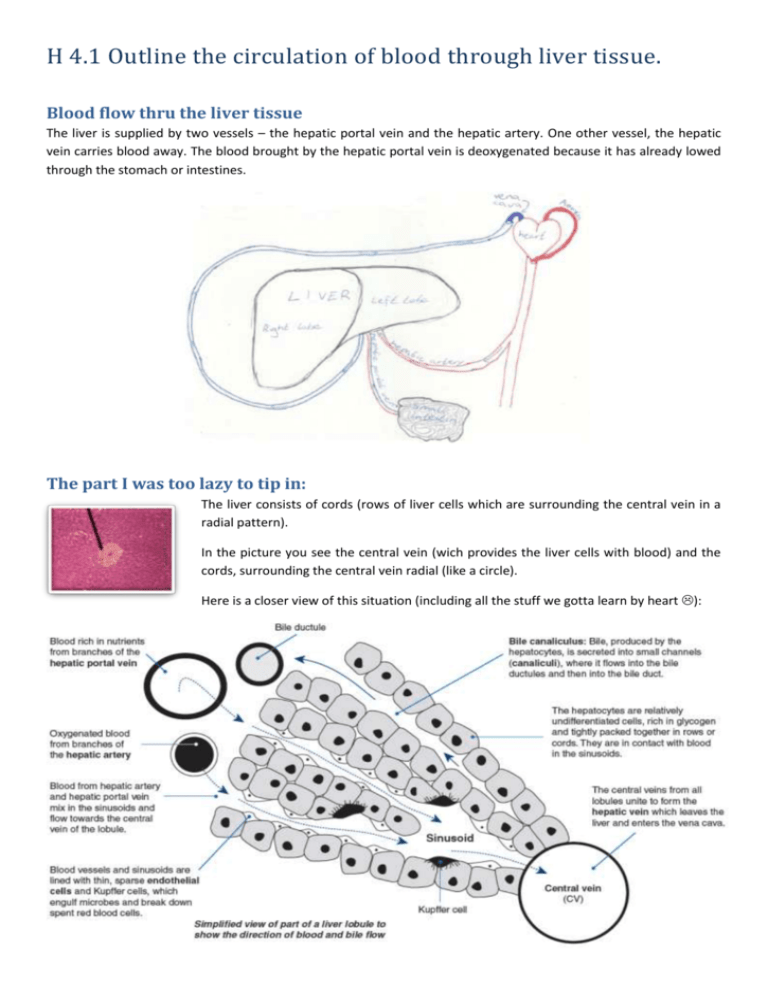1. Inflammation – swelling of damaged liver tissue
advertisement

H 4.1 Outline the circulation of blood through liver tissue. Blood flow thru the liver tissue The liver is supplied by two vessels – the hepatic portal vein and the hepatic artery. One other vessel, the hepatic vein carries blood away. The blood brought by the hepatic portal vein is deoxygenated because it has already lowed through the stomach or intestines. The part I was too lazy to tip in: The liver consists of cords (rows of liver cells which are surrounding the central vein in a radial pattern). In the picture you see the central vein (wich provides the liver cells with blood) and the cords, surrounding the central vein radial (like a circle). Here is a closer view of this situation (including all the stuff we gotta learn by heart ): Explain the difference between sinusoids and capillaries. “Between the cords are blood spaces called SINUSOIDS ” – Further human physiology (Option H), page 15 blue box CAPILLARIES are blood vessels (they are “tubes which transport blood; like arteries and veins) and not just empty spaces which are filled up with blood. H 4.2 Explain the role of the liver in regulating levels of nutrients in the blood. Book's version: Put in simpler words: The liver regulates the concentration of certain substances. These are the following: Metabolizes amino acids, fats and carbohydrates (does that by secreting bile). Stores iron, copper and vitamins (so the concentration of them isn’t dropping too strongly in “bad times”. Converts unwanted amino acids into urea (the yellow thing in your piss). So the concentration in blood of these isn’t too high. Detoxifies poisons or puts them into less harmful forms “eliminate” worn-out blood cells The liver also synthesizes (manufacture) things: Cholesterol Glucose (when glycogen stores are exhausted) Heparin and plasma proteins You know what the ER and Golgi apparatus in hepatocytes (=liver cells) produce The endoplasmatic reticulum assembles proteins. The Golgi apparatus does the last step in assembling them. If we imagine a cell as a factory, the endoplamatic reticulum would be step 4 and the Golgi apparatus step 6 (it packages them, does the very last step). In a liver cell, the main proteins being produced are plasma proteins and cholesterol. So … Know that the endoplasmatic reticulum and the Golgi apparatus in hepatocytes produce plasma protein and cholesterol. H 4.5 State that the liver has a role of detoxification. The best known function of the liver is that it detoxifies poisons (like alcohol etc.). H 4.6 Describe the process of erythrocyte and hemoglobin breakdown in the liver. ERYTHROCYTES = RED BLOOD CELLS 1. Erythrocyte dies They contain hemoglobin 2. Kupffer cells break down the haemoglobin into globin and heme groups Kupffer cells can be found in the sinusoids of the liver 3. Globin is digested by peptidases to produce amino acids. These amino acids are either used to build new proteins or are digested by the liver 4. Heme groups are broken down into iron and bilirubin (bile pigment) 5. The iron gets either stored in the liver or gets transported to the bone marrow (Knochenmark) where new erythrocytes are formed out of it. The bilirubin is transported to the liver. There it helps the liver to metabolize other substances (as the liver secrets bile in order to digest them). The steps on the left hand side happen at the same time as the steps at the right hand side (I had an issue numbering them). Iron is carried to the bone marrow to produce new hemoglobin. As you might have noticed, the body has developed a great recycling circle. As the granny erythrocyte dies, its iron is utilized to form new hemoglobin (new erythrocytes) out of it. Surplus cholesterol is converted to bile pigments. One of the functions of cholesterol is to synthesize cholesterol (an important protein which fulfills a lot of functions). However, if the produces too much cholesterol and there’s a cholesterol surplus, the cholesterol gets converted back to bile again, which can be used by the liver. Explain the liver damage caused by excessive alcohol consumption When the liver metabolizes alcohol it forms substances which are toxic to cells. This leads to replacement of healthy liver cells with fibrous scar tissue This has the following consequences: It blocks normal metabolism of carbohydrates, fats & proteins It reduces liver’s ability to transport materials around the body (blocks blodflow to and from liver) Over time this may lead to nutritional lack (body can’t digest nutrients that good anymore) and an increased sensitivity to infection (because of lack of nutrients [?]). Long term alcohol abuse (i.e. excessive drinking) results in three primary effects upon the liver: 1. Inflammation – swelling of damaged liver tissue 2. Fat accumulation – build-up of fat in place of normal liver tissue 3. Cirrhosis – scar tissue left when areas of liver are destroyed by prolonged alcohol exposure The causes and consequences of jaundice Jaundice is disease where you get yellow skin or eyes. The yellow color comes from bilirubin (used by the liver to matabolize stuff, see Page 2, H4.6). Causes: Jaundice is mostly caused by a liver or gall or pancreas disease. This disease can be caused by different things (e.g. Eating poisonous mushrooms or other poisons, Viral infection of the liver (hepatitis), parasite infection of the liver, gallstone, …) Or by a disorder like blocked or narrowed bile ducts (by infection, tumor, stricture, or gallstones), Primary biliary cirrhosis, bile build up in the gallbladder because of pressure in the belly area during pregnancy (jaundice of pregnancy). Consequences: Severe jaundice in newborn babies can cause a number of health problems. For this reason it is monitored closely, and special treatments such as phototherapy may be recommended by a paediatrician. In adults, the jaundice itself usually doesn't cause any particular problem, apart from some itching. However, it may cause nausea and a fever, upper abdominal pain, dark urine and pale stools.






